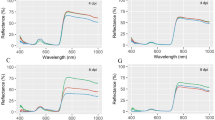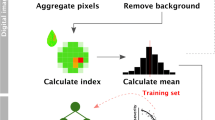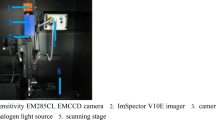Abstract
Bacterial leaf blight (BLB) is an important vascular disease of irrigated rice and serious infestations may cause a significant loss of yield. This study analyzed hyperspectral canopy reflectance spectra of two rice cultivars with different susceptibilities to BLB to establish spectral models for assessing disease severity for future site-specific management. The results indicated that wavebands from 757 to 1039 nm were the most sensitive region of the spectrum for the moderately susceptible cultivar TNG 67, whereas most narrow bands showed a significant relationship for the highly susceptible cultivar TCS 10. All the spectral indices (SIs) calculated had significant relationships with proportions of infested area in cultivar TCS 10, but only two SIs correlated significantly with cultivar TNG 67. The relation between the severity of the disease and spectral reflectance for the less susceptible cultivar TNG 67 can be improved by using a multiple linear regression approach.














Similar content being viewed by others
References
Adhikari, T. B., Mew, T. W., & Teng, P. S. (1994). Progress of bacterial blight on rice cultivars carrying different Xa genes for resistance in the field. Plant Disease, 78, 73–77.
Aldakheel, Y. Y., & Danson, F. M. (1997). Spectral reflectance of dehydrating leaves: measurements and modeling. International Journal of Remote Sensing, 18, 3683–3690. doi:10.1080/014311697216883.
Asner, G. P. (1998). Biophysical and biological sources of variability in canopy reflectance. Remote Sensing Environmental, 64, 234–253. doi:10.1016/S0034-4257(98)00014-5.
Barrett, E. C., & Curtis, L. F. (1992). Introduction to environmental remote sensing (3rd ed.). London: Chapman & Hall.
Carter, G. A., & Knapp, A. K. (2001). Leaf optical properties in higher plants: Linking spectral characteristics to stress and chlorophyll concentration. American Journal of Botany, 88, 677–684. doi:10.2307/2657068.
Elings, A., Reddy, P. R., Marimuthu, T., Rossing, W. A. H., Jansen, M. J. W., & Teng, P. S. (1997). Rice bacterial leaf blight: Field experiments, systems analysis and damage coefficients. Field Crops Research, 51, 113–131. doi:10.1016/S0378-4290(96)01036-2.
Fei, F.-W., & Wang, Y.-M. (2002). Plant protection handbook. Taichung Hsien, Taiwan, ROC: Taiwan Agricultural Chemicals and Toxic Substances Research Institute. 791 pp.
Forestry Images. (2008). Trees, plants, and stand types-bacterial leaf blight of rice. http://www.forestryimages.org/browse/detail.cfm?imgnum=0162039. Accessed 18 Jan 2008.
GER 2600 User Manual. (1996). Version 1.1. Millbrook, New York: Geophysical & Environmental Research Corporation.
Hall, A., Lamb, D. W., Holzapfel, B., & Louis, J. (2002). Optical remote sensing applications for viticulture—a review. Australian Journal of Grape and Wine Research, 8, 36–47. doi:10.1111/j.1755-0238.2002.tb00209.x.
Hsieh, S.-P.-Y. (1991). Recent status and future prospects on bacterial blight in Taiwan. In Proceedings of symposium on research of rice diseases in Taiwan. Special report no. 32 (pp. 117–130). Taichung Hsien, Taiwan, ROC: Taiwan Agricultural Research Institute.
Invasive Species. (2008). Invasive and exotic diseases-bacterial leaf blight of rice. No. 0162037-0162039. http://www.invasive.org/browse/subject.cfm?sub=11182. Accessed 18 Jan 2008.
Kauffman, H. E., Reddy, A. P. K., Hsieh, S. P. Y., & Merca, S. D. (1973). An improved technique for evaluating resistance of rice varieties to Xanthomonas oryzae pv. oryzae. Plant Dis Rep, 57, 537–541.
Khush, G. S. (2005). What it will take to feed 5 billion rice consumers in 2030. Plant Molecular Biology, 59, 1–6. doi:10.1007/s11103-005-2159-5.
Knippling, E. B. (1970). Physical and physiological basis for differences in reflectance of visible and near-infrared radiation from vegetation. Remote Sensing Environmental, 1, 155–159. doi:10.1016/S0034-4257(70)80021-9.
Kobayashi, T., Kanda, E., Kitada, K., Ishiguro, K., & Torigoe, Y. (2001). Detection of rice panicle blast with multispectral radiometer and the potential of using airborne multispectral scanners. Phytopathology, 91, 316–323. doi:10.1094/PHYTO.2001.91.3.316.
Kumar, L., Schmidt, K. S., Dury, S., & Skidmore, A. K. (2001). Review of hyperspectral remote sensing and vegetation science. In F. D. Van, S. M. der Meer, & De. Jong (Eds.), Imaging spectrometry: Basic principles and prospective applications (pp. 111–155). Dordrecht, The Netherlands: Kluwer Academic Press.
Lee, Y.-J., Yang, C.-M., Chang, K.-W., & Shen, Y. (2008). A simple spectral index using reflectance of 735 nm to assess nitrogen status of rice canopy. Agronomy Journal, 100, 205–212. doi:10.2134/agrojnl2007.0018.
Lorenzen, B., & Jensen, A. (1989). Changes in spectral properties induced in barley by cereal Powdery Mildew. Remote Sensing Environmental, 27, 201–209. doi:10.1016/0034-4257(89)90018-7.
Malthus, T. J., & Madeira, A. C. (1993). High resolution spectroradiometry: spectral reflectance of field bean leaves infected by Botrytis fabae. Remote Sensing Environmental, 45, 107–116. doi:10.1016/0034-4257(93)90086-D.
Mew, T. W. (1987). Current status and future prospects of research on bacterial blight of rice. Annual review of Phytopathology, 25, 359–382. doi:10.1146/annurev.py.25.090187.002043.
Muko, H., Kusaba, T., Watanabe, M., Tabei, H., & Tsuchiya, Y. (1957). Effect of major environmental factors on the development of bacterial leaf blight of rice. Annals of the Phytopathological Society of Japan, 29, 13–19.
Nilsson H. E. (1985a). Remote Sensing of 2-row Barley Infected by Net Blotch Disease. Växtskyddsrapporter–Jordbruk, 34. Uppsala, Sweden: Swedish Agricultureal University, SLU.
Nilsson H. E. (1985b). Remote Sensing of 6-row Barley Infected by Net Blotch Disease. Växtskyddsrapporter–Jordbruk, 36. Uppsala, Sweden: Swedish Agricultureal University, SLU.
Ogawa, T., Tabien, R. E., Yamamoto, T., Bustro, G. A., Jr., & Ikeda, R. (1991). Breeding of near-isogenic lines for resistance to rice bacterial blight. In S. J. Banta & G. S. Argosino (Eds.), Rice genetics II (pp. 742–743). Los Banos, Philippines: International Rice Research Institute.
Ou, S. H. (1985). Rice diseases (2nd ed.). Kew, England: Commonwealth Mycological Institute.
Rollin, E. M., & Milton, E. J. (1998). Processing of high spectral resolution reflectance data for the retrieval of canopy water content information. Remote Sensing Environmental, 65, 86–92. doi:10.1016/S0034-4257(98)00013-3.
SAS Institute. (1998). SAS/STAT user’s guide, Version 8.1. Cary, NC: SAS Institute.
Seager, S., Turner, E. L., Schafer, J., & Ford, E. B. (2005). Vegetation’s red edge: A possible spectroscopic biosignature of extraterrestrial plants. Astrobiology, 5, 372–390. doi:10.1089/ast.2005.5.372.
Sharp, E. L., Perry, C. R., Scharen, A. L., Boatwright, G. O., Sands, D. C., Lautenschlager, L. F., et al. (1985). Monitoring cereal rust development with a spectral radiometer. Phytopathology, 75, 936–939. doi:10.1094/Phyto-75-936.
Singh, S., Sidhu, J. S., Huang, N., Vikal, Y., Li, Z., Brar, D. S., et al. (2001). Pyramiding three bacterial blight resistance genes (xa5, xa13 and xa21) using marker-assisted selection into indica rice cultivar PR 106. Theoretical and Applied Genetics, 102, 1011–1015. doi:10.1007/s001220000495.
Singh, G. P., Srivastava, M. K., Singh, R. V., & Singh, R. M. (1977). Variation in quantitative and qualitative losses caused by bacterial blight in different rice varieties. Indian Phytopathology, 3, 180–185.
Srivastava, D. N. (1972). Bacterial blight of rice. Indian Phytopathology, 25, 1–16.
Steven, M. D., Malthus, T. J., Demetriades-Shah, T. H., Danson, F. M., & Clark, J. A. (1990). High resolution spectral indices for crop stress. In M. D. Steven & J. A. Clark (Eds.), Applications of remote sensing in agriculture (pp. 209–227). London, UK: Butterworth.
Texas Plant Disease Handbook. (2008). Rice, Oryza sativa. Bacterial Leaf Blight Symptoms on Rice. http://plantpathology.tamu.edu/Texlab/Grains/Rice/riceblb.html. Accessed 19 Jan 2008.
Tsai, W.-H. (1991). Prediction of rice leaf blast. In C.-C. Tu et al. (Eds.), Proceedings of symposium on research of rice diseases in Taiwan. Special report no. 32 (pp. 15–30). Taichung Hsien, Taiwan, ROC: Taiwan Agricultural Research Institute.
Tu, C.-C., & Chang, Y.-C. (1991). Ecology and control of sheath blight of rice. In C.-C. Tu et al. (Eds.), Proceedings of symposium on research of rice diseases in Taiwan. Special report no. 32 (pp. 65–81). Taichung Hsien, Taiwan, ROC: Taiwan Agricultural Research Institute.
West, J. S., Bravo, C., Oberti, R., Lemaire, D., Moshou, D., & McCartney, H. A. (2003). The potential of optical canopy measurement for targeted control of field crop disease. Annual Review of Phytopathology, 41, 593–614. doi:10.1146/annurev.phyto.41.121702.103726.
Wooley, J. T. (1971). Reflectance and transmittance of light by leaves. Plant Physiology, 47, 656–662. doi:10.1104/pp.47.5.656.
Yang, C.-M., & Chen, R.-K. (2004). Modeling rice growth using hyperspectral reflectance data. Crop Science, 44, 1283–1290.
Yang, C.-M., Cheng, C.-H., & Chen, R.-K. (2007). Changes in spectral characteristics of rice canopy infested by leaf folder and brown planthopper. Crop Science, 47, 329–335. doi:10.2135/cropsci2006.05.0335.
Acknowledgments
The author wish to give thanks to Council of Agriculture (90AS-8.1.1-CI-C1 and 94AS-8.2.1.-CI-C1), Executive Yuan, Taiwan ROC for the financial support and Mr. Yih-Chang Chang, Plant Pathologist of Taiwan Agricultural Research Institute, for the assistance in identification of disease severity. The technical assistance in spectral measurements provided by Dr. Yuh-Jyuan Lee of TARI is also gratefully appreciated.
Author information
Authors and Affiliations
Corresponding author
Rights and permissions
About this article
Cite this article
Yang, CM. Assessment of the severity of bacterial leaf blight in rice using canopy hyperspectral reflectance. Precision Agric 11, 61–81 (2010). https://doi.org/10.1007/s11119-009-9122-4
Received:
Accepted:
Published:
Issue Date:
DOI: https://doi.org/10.1007/s11119-009-9122-4




